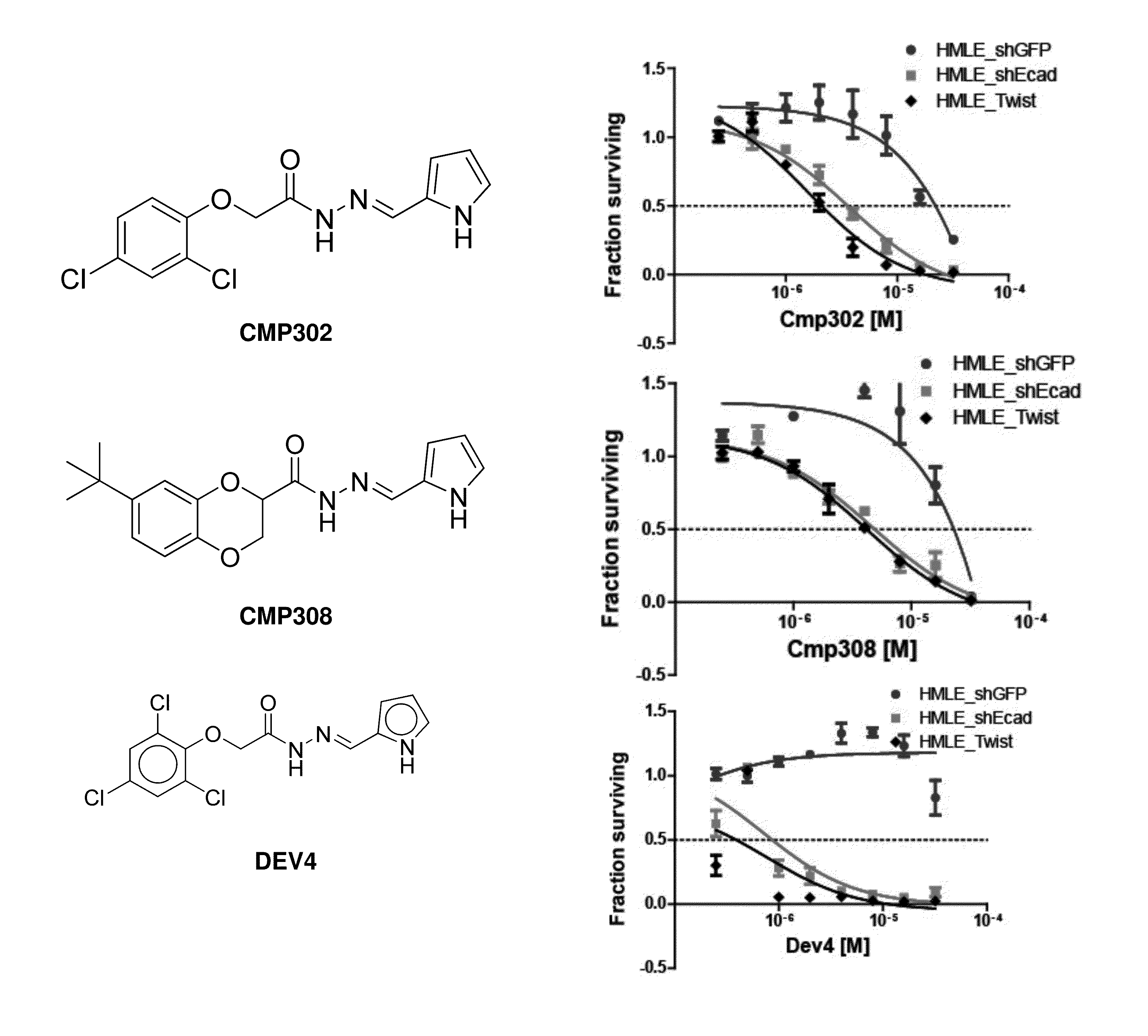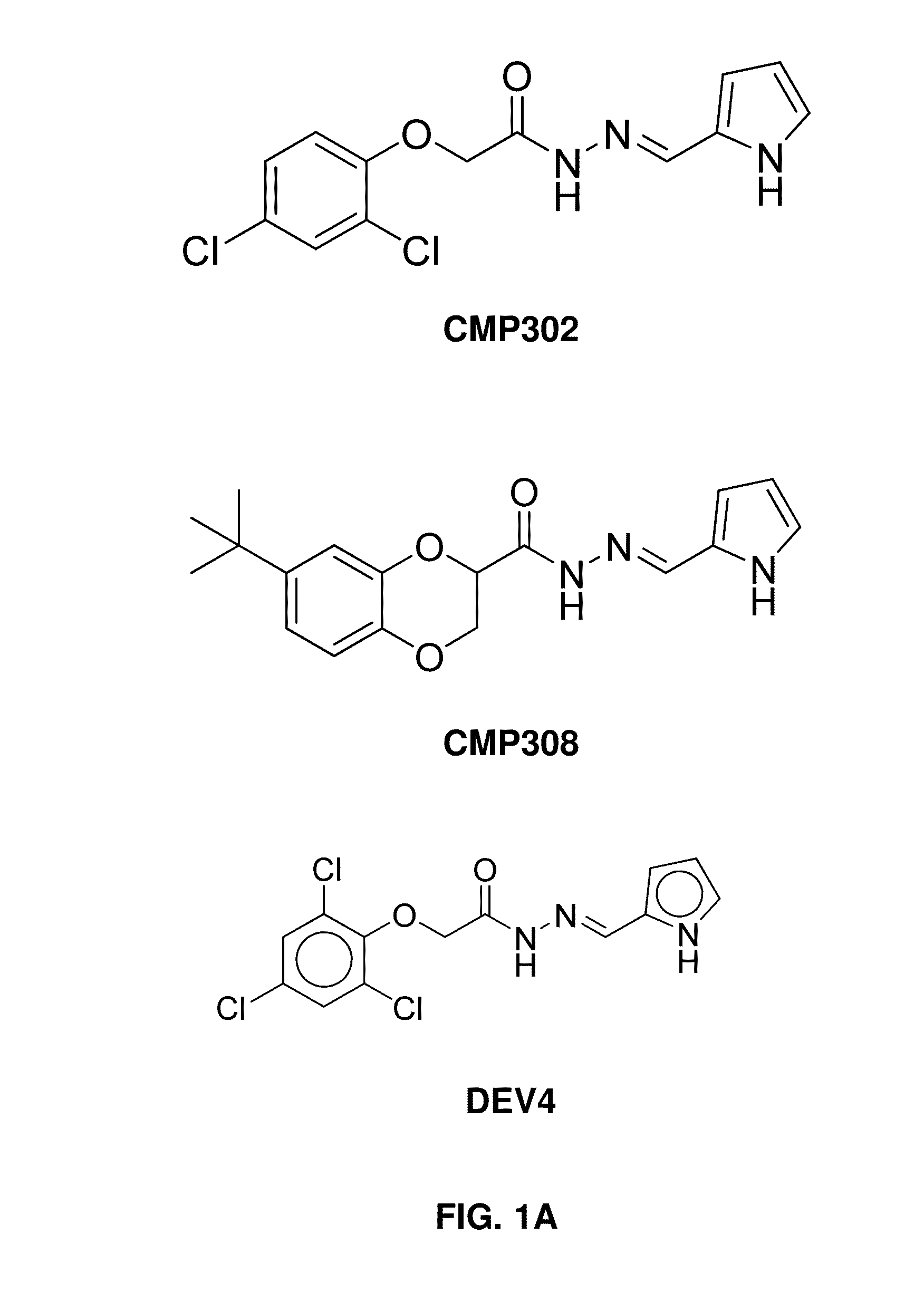ER-stress inducing compounds and methods of use thereof
a technology of stress inducing compounds and compounds, applied in the field of compounds, can solve the problems of insufficient metastatic ability alone for tumor dissemination, csc intrinsic resistance and invasiveness of certain cscs, and the basis of intrinsic therapeutic resistance and invasiveness remains minimally understood, and achieve the effect of de-bulking tumors
- Summary
- Abstract
- Description
- Claims
- Application Information
AI Technical Summary
Benefits of technology
Problems solved by technology
Method used
Image
Examples
example 1
Characterization of Small Molecules with Selective Toxicity Towards IDMS Cells
[0398]A recent report described two structurally similar compounds, Cmp302 and Cmp308, that exhibit 20-fold selective toxicity towards invasive, drug-resistant, mesenchymal, stem-like cells (hereafter IDMS, to emphasize these various phenotypic traits) (FIG. 1A, 1B) (Germain et al., 2012). These compounds displayed selective toxicity towards immortalized human mammary epithelial cells (HMLE) induced through EMT either by inhibition of E-cadherin (shEcad) or overexpression of Twist, indicating that their selective toxicity did not depend on the means of EMT induction (FIG. 1B). The selectivity of these compounds was retained when HMLE epithelial cells were transformed by an oncogenic RasV12 allele (FIG. 1C).
[0399]Even though Cmp302 and Cmp308 were selective for IDMS cells when cultured alone, tumors are comprised of heterogeneous populations of cells that could affect the sensitivity or selectivity of the a...
example 2
Genome-Wide shRNA Screen to Identify Genetic Interactions with Compound Treatment
[0404]To identify the mechanism by which the selective small-molecules exert their toxicity towards IDMS cells, a genome-scale shRNA screen was performed to identify genetic interactions with Cmp302 treatment (FIG. 2A). For this experiment, IDMS breast epithelial cells (HMLE_Twist) first were stably transduced with a complex mixture of ˜55,000 shRNAs; these infections were performed at a low multiplicity of infection to ensure that the vast majority of cells expressed a single shRNA. After expansion in culture, the shRNA-transduced cells were treated with either Cmp302 at its IC95 dose or with a vehicle control. Following chemical treatment, genomic DNA was isolated from the surviving cells and used PCR, followed by next-generation sequencing, to quantify the relative numbers of surviving cells with each introduced shRNA.
[0405]The analysis of the quantitative screen data was divided into three steps. Fi...
example 3
IDMS Cells are Sensitized to ER Stress
[0408]The shRNA screen results described in Example 2 indicated that reducing ER load by knockdown of secreted proteins in IDMS cells leads to Cmp302 resistance. Conversely, compromising ER function by disruption of vesicular transport, lipid synthesis or protein glycosylation further sensitized cells to Cmp302-induced death. Based on these findings, it was hypothesized that Cmp302 could be causing cell death by compromising ER function.
[0409]Cmp302 treatment triggered a dosage-dependent increase in UPR signaling, including increased XBP1 splicing, eIF2α phosphorylation and ATF6 activation (FIG. 3A and FIG. 8A). Additionally, there was a strong induction of downstream UPR factors including CHOP and Bip (FIG. 3A, FIG. 8B). These ER stress-associated signaling alterations occurred at a lower dose in IDMS carcinoma cells when compared to non-IDMS cells (FIG. 3A).
[0410]Dev4 is a derivative of Cmp302 optimized for potency and selective toxicity. Dev4...
PUM
 Login to View More
Login to View More Abstract
Description
Claims
Application Information
 Login to View More
Login to View More - R&D
- Intellectual Property
- Life Sciences
- Materials
- Tech Scout
- Unparalleled Data Quality
- Higher Quality Content
- 60% Fewer Hallucinations
Browse by: Latest US Patents, China's latest patents, Technical Efficacy Thesaurus, Application Domain, Technology Topic, Popular Technical Reports.
© 2025 PatSnap. All rights reserved.Legal|Privacy policy|Modern Slavery Act Transparency Statement|Sitemap|About US| Contact US: help@patsnap.com



